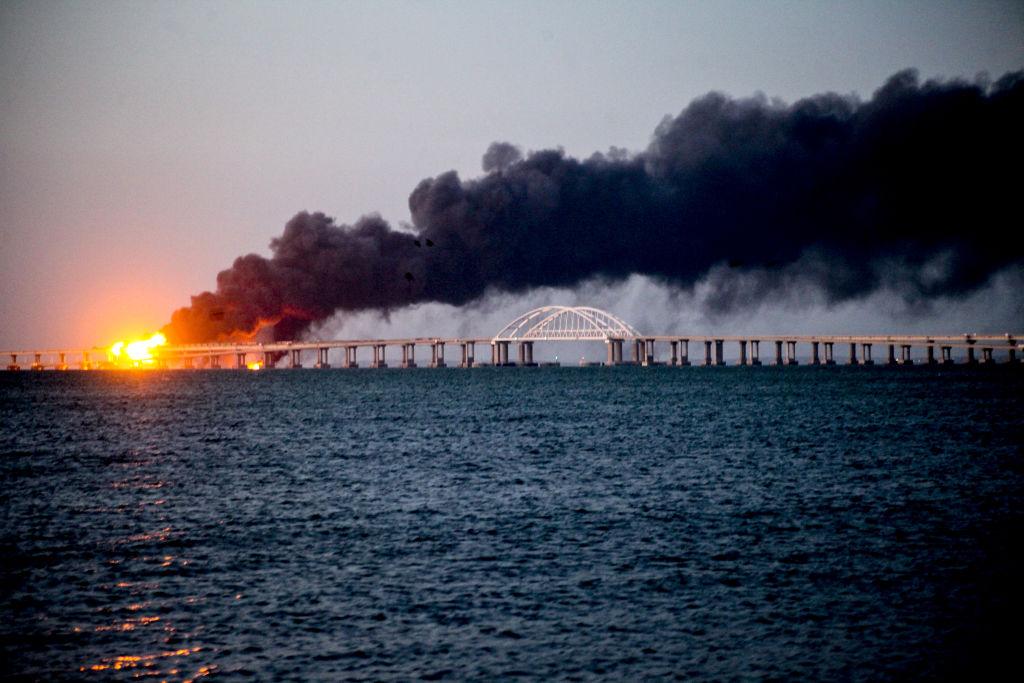
In the early hours of Saturday 8 October, an explosion on the Kerch Strait Bridge connecting Russia to Crimea demolished lengths of its road and railway tracks. Commentators in Ukraine are saying there are three possible explanations for what happened: the bridge was mined, explosives carried on a truck were detonated on the bridge, or the bridge was targeted by rocket attack. It is considered unlikely that the Iranian drones that were being transported in the truck ignited spontaneously.
We don’t yet know who is responsible. Ukraine doesn’t have adequate rocket capacity to have targeted the bridge from a distance. If Ukrainian forces were responsible, it’s worth noting that the attack occurred very early in the morning before the bridge was busy with daily traffic, in stark contrast to Russian attacks, which have consistently targeted civilians. The office of the Ukrainian president has said that the attack on the bridge was a result of internal friction within Russia itself. The arrest of eight people by Russia’s Federal Security Service because they allegedly ‘participated in the preparation of the crime’ is not credible, given Russia’s track record in disinformation and President Vladimir Putin’s need to find a scapegoat quickly.
Regardless of who is responsible, the damage to the bridge undoubtedly provides a military advantage for Ukraine. The Kerch bridge is a major supply line for Russian military personnel and weapons as well as a route into Crimea, which then allows access to southern Ukraine. However, the attack on the bridge is also of immense symbolic significance. The war began eight years ago with the annexation of Crimea, and the Kerch bridge became a symbol of Russian occupation of the peninsula.
The bridge was built at huge expense four years after Russia’s annexation of Crimea. It opened with great fanfare and a motorcade of formidable Kamaz trucks, one of which was driven by Putin himself. Footage of him behind the steering wheel, a Russian flag by his side, was beamed across television screens in Russia as a sign of imperial victory. Now there is another televised image flooding screens—that very same bridge in flames, again with a truck on it, but this time with three of its four spans severely damaged. Ukraine’s official silence, which has led to much tongue-in-cheek commentary on social media, magnifies the symbolic impact.
The Ukrainian Postal Service is now issuing a new postage stamp to capitalise on the event’s symbolic significance, the third in a series released since Russia’s full-scale invasion of Ukraine. The first stamp showed a silhouette of a Ukrainian soldier raising his middle finger in a display of profanity facing an image of the Russian flagship Moskva, which was destroyed by a Ukrainian-made missile. The second stamp featured a Ukrainian tractor towing away a Russian tank. The new stamp will include a drawing of the Kerch Strait Bridge in flames, presenting a third image symbolising Russian military failure.
Meanwhile, there are fractures emerging in Russia itself, between Putin, the military and others who hold financial or ideological power in the regime, such as oligarchs, military bloggers and propagandists. This has come to the fore with the recent mobilisation drive, which has divided the Russian population. At the same time, the Ukrainian counteroffensive, which has reclaimed more than 9,000 square kilometres of occupied territory since it was launched on 29 August, has been remarkably successful and is maintaining momentum.
It had been claimed by the Kremlin-controlled media that it was impossible to destroy the Kerch Strait Bridge because it was shielded by some 20 different protection systems. That has been proven wrong. Regardless of whether Russian or Ukrainian elements were responsible for the damage to the bridge, either way it looks bad for Putin.
What also looks bad is his brutal act of retaliation—84 missiles struck 15 cities across Ukraine the following day. Timed to coincide with the busy morning peak hour, Russian rockets rained death and destruction in attacks on innocent civilians, including in the cultural precinct of the capital city Kyiv. More and more, the world sees that Putin’s aim is nothing less than total destruction of Ukraine.